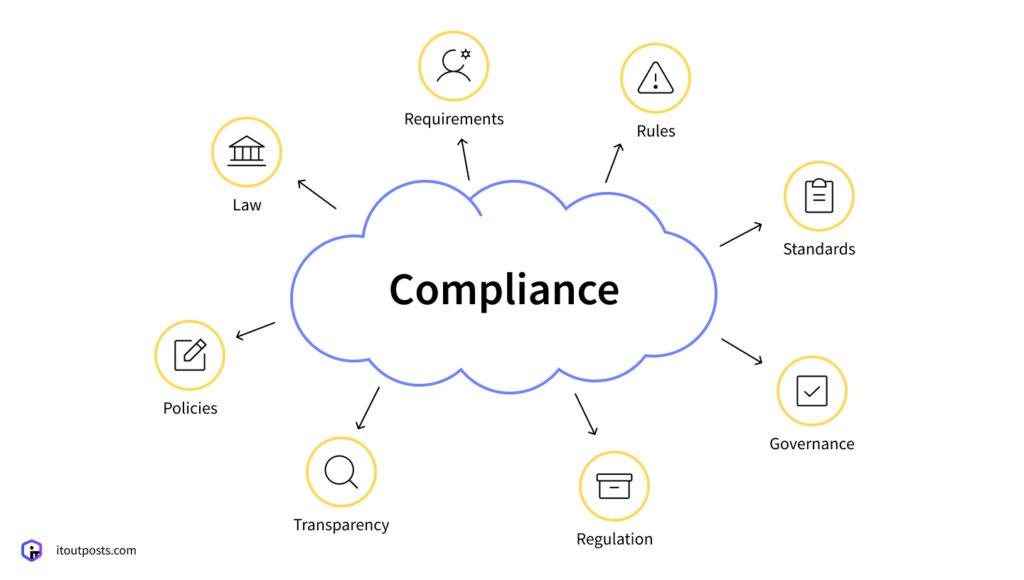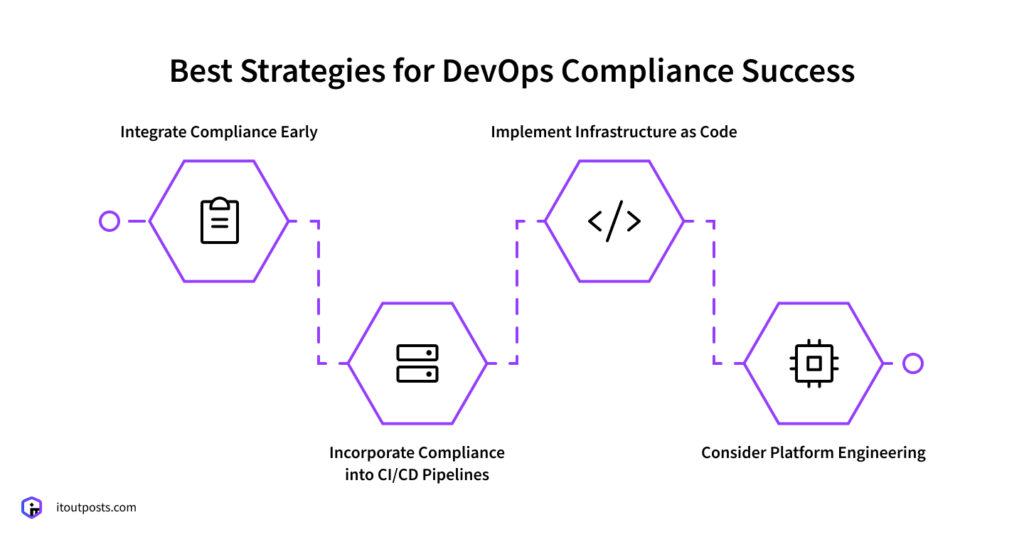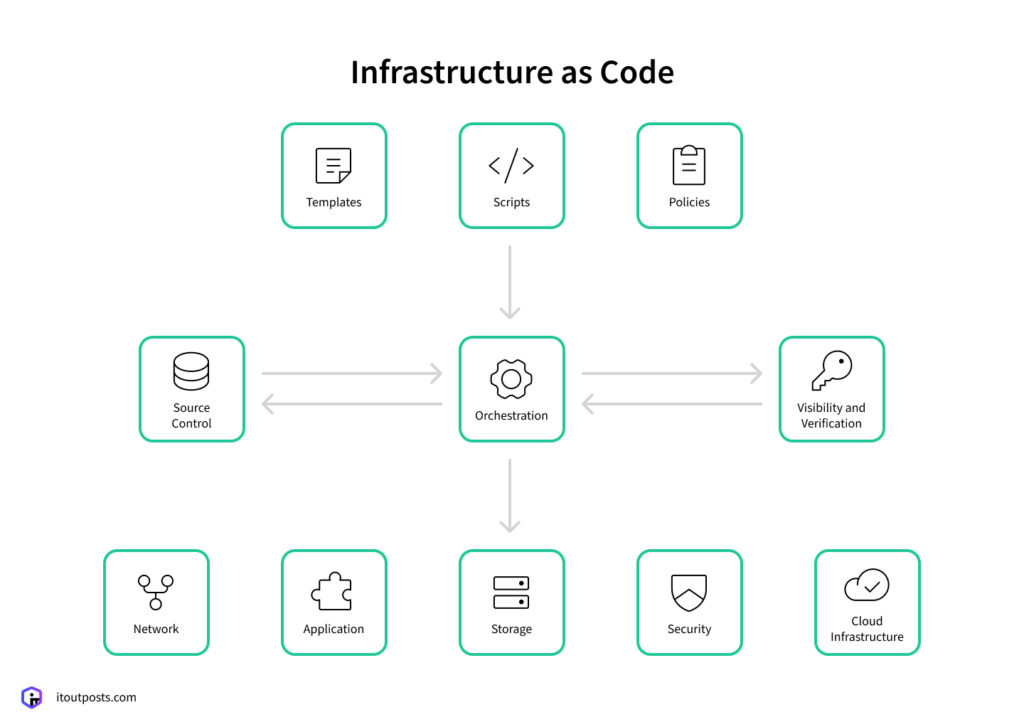Contents
DevOps has completely changed the way we deliver software, but let’s not forget that compliance requirements are still very much in the picture. A lot of teams see these regulations as challenges that slow down the speed that DevOps promises. But here’s the thing: compliance and DevOps are actually on the same team — they both aim for quality, reliability, and building trust.
In this article, we’ll walk you through the ways to bring together these two seemingly opposing forces. Read on to discover practical tips on how to weave compliance into your DevOps practices right from the start.Necessary Compliance Standards in DevOps Environments

Compliance challenges are something every DevOps team deals with. However, these frameworks actually help shape your software development and delivery processes. Here’s the list of some major compliance standards:
- ISO 27001 sets the standard for information security. It encourages you to identify risks and implement controls to protect sensitive data. You need to make sure your DevOps pipeline includes security checks, proper documentation, and change tracking. Companies aim for this certification to show their commitment to security to customers and partners.
- GDPR has transformed the way we handle personal data in Europe. It requires that we get clear user consent and allows people to request the deletion of their personal data. Many teams are now incorporating privacy checks into their testing processes to catch any issues before release.
- HIPAA is about keeping patient health data safe in the US. It requires strict access controls, encryption, and detailed audit logs. The stakes are high — violating these rules can lead to hefty fines.
- DORA is focused on making sure that financial services in Europe are resilient to digital threats. It encourages banks and fintech companies to create systems that can handle cyber-attacks and operational hiccups. Your DevOps teams should run tests for various disaster scenarios. As financial services keep becoming more digitized, this regulation is only going to gain importance.
- SOC 2 Type 2 looks at your security controls over a period of time. Auditors monitor your practices for several months to ensure you’re keeping them consistent. Therefore, your DevOps team has to gather evidence of compliance throughout the software delivery process. And, in fact, a lot of enterprise clients won’t even consider your product unless you have this certification.
Common Compliance Challenges for DevOps Teams
Software teams often find it tricky to juggle speed with compliance needs. Let’s find out some of the main challenges you might encounter when putting compliant DevOps practices into action.

Documentation Overhead
Many compliance frameworks require a lot of documentation. Your team needs to keep track of code changes, infrastructure updates, and security decisions. Yet, the paperwork can slow down developers who would rather write code than fill out forms.
Instead of skipping documentation, think about automating it. You can integrate tools that gather compliance evidence during the development process without your intervention.
Security vs. Speed Conflicts
Developers often feel the pressure to deliver new features quickly. In such conditions, security reviews and compliance checks may seem like annoying roadblocks.
The winning strategy is to weave security into the pipeline so you don’t have to treat it as a last-minute obstacle. By using automated security scans and compliance checks that run alongside builds, you can keep up the pace.
Infrastructure Complexity
Modern applications rely on cloud services, containers, and microservices. Together, these components create a complex security environment. Each component needs to be configured correctly, monitored, and have proper access controls. If infrastructure is misconfigured, you risk both security vulnerabilities and compliance issues.
The solution? We recommend adopting infrastructure-as-code (IaC) practices to make security configurations consistent and easy to audit.
Access Control Management
Compliance frameworks come with some pretty strict rules about who can access systems and data. Managing permissions across development, testing, and production environments can really be a challenge, especially when team members change. To make things easier while still staying compliant, it’s a good idea to go with least-privilege access by default and automate your permission workflows.
Audit Readiness
Surprise audits cause panic in unprepared teams. When you have to gather evidence during an audit, it can take away from time spent on development. A better approach is to aim for continuous audit readiness. This means you should collect compliance evidence automatically as part of your pipeline, and this is how you’re always ready for the next audit.
Third-Party Risk Management
Modern applications rely heavily on open source components and third-party services. But keep in mind that each external dependency can introduce compliance risks. After all, your application is only as compliant as its weakest link.
That’s why your team needs to make sure these components meet your compliance standards. Automated software composition analysis tools can help track and validate those dependencies throughout the development lifecycle.
Best Strategies for DevOps Compliance Success
Yes, challenges may not sound easy to deal with, but here’s the good news: there are ways to tackle them and keep everything running smoothly. Let’s look at some practical tips for blending compliance with DevOps without adding extra stress to your team.

Integrate Compliance Early
The best time to start thinking about compliance is right at the beginning. This allows developers to naturally build compliant features as they go along.Incorporate Compliance into CI/CD Pipelines
Your delivery pipeline can do more than test features; it can include compliance checks that run automatically with every build. By integrating these checks, you make compliance a regular part of your workflow.
Teams quickly learn what passes and what fails, and these automated checks create great documentation for audits — the pipeline tracks what was tested and when, so you don’t have to remember details months in the future.
Implement Infrastructure as Code

When your infrastructure is managed in code, compliance becomes a lot easier. Every server configuration, security setting, and access policy is clear and available in your code repository.
Changes are reviewed just like application code, which helps create natural audit trails and ensures consistency across different environments. Plus, when auditors have questions, you can refer them to specific pieces of code.
Consider Platform Engineering
Many organizations are now developing internal platforms that come with built-in compliance. These platforms offer pre-approved components that developers can use without getting bogged down by compliance details.
The platform team tackles these complex requirements upfront, providing building blocks that everyone can use. Thanks to platform engineering, developers can focus on creating features while still meeting all compliance needs.
How Our AMIX Infrastructure Helps You Follow Compliance Effort-Free
AMIX is our pre-built solution designed for teams eager to adopt DevOps without dealing with compliance issues. This ready-to-go platform becomes completely yours, with expert support from IT Outposts.
It comes with everything you need: IaC, multi-environment setup, VPN configuration, Kubernetes orchestration, monitoring, alerting, and built-in compliance to meet key regulations.
Once deployed, you can use it across multiple projects. It scales up easily as your needs grow, while staying secure. Here’s how AMIX simplifies compliance:
- End-to-end encryption keeps your data safe, whether it’s in transit or stored. We use strong, industry-standard encryption throughout the pipeline. This means your sensitive information stays protected from unauthorized access, helping you meet data protection requirements effortlessly.
- Smart access controls limit the operations your team members can conduct within your system. Our platform has role-based permissions, emphasizes least-privilege principles, and includes multi-factor authentication. This way, you create clear boundaries that meet auditors’ expectations and, at the same time, shield your systems from both external and internal threats.
- Built-in security testing allows you to detect issues before they can escalate. Security checks automatically run at every stage of your pipeline, scanning code, dependencies, and containers for vulnerabilities.
- IaC ensures predictable, secure environments. Instead of relying on manual configurations that can vary between deployments, AMIX uses code to generate identical, hardened environments every time. And this is essential for both security and passing audits.
- Comprehensive logging automatically creates your audit trail. Every activity across environments gets recorded. When auditors request evidence, you’ll have everything they need already organized and accessible.
- Fast incident response helps you meet breach reporting requirements. The platform quickly detects security incidents, classifies them by severity, and follows your escalation procedures.
- Smart data management takes care of retention and deletion policies for you. The system lets you minimize unnecessary data storage and removes information when it’s no longer needed. This feature is especially useful for privacy regulations like GDPR.
- Supply chain security enables you to keep an eye on your external dependencies. The platform continuously monitors third-party components, libraries, and services for vulnerabilities. This is how you can extend your security perimeter to cover everything your applications rely on.
- Traceable changes meet auditor questions about your team’s activities. Every code change, infrastructure update, and configuration adjustment follows controlled workflows with peer reviews and policy checks.
- Multi-framework compliance is built into the foundation. AMIX incorporates controls directly aligned with ISO 27001, SOC 2, NIST CSF, GDPR, HIPAA, CCPA, and DORA requirements. Whether in healthcare, finance, or other regulated industries, you’ll start with a strong compliance framework.

I am an IT professional with over 10 years of experience. My career trajectory is closely tied to strategic business development, sales expansion, and the structuring of marketing strategies.
Throughout my journey, I have successfully executed and applied numerous strategic approaches that have driven business growth and fortified competitive positions. An integral part of my experience lies in effective business process management, which, in turn, facilitated the adept coordination of cross-functional teams and the attainment of remarkable outcomes.
I take pride in my contributions to the IT sector’s advancement and look forward to exchanging experiences and ideas with professionals who share my passion for innovation and success.